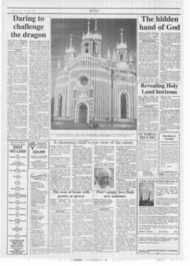Page 8, 5th June 1992
Page 8

Report an error
Noticed an error on this page?If you've noticed an error in this article please click here to report it.
Tags
Share
Related articles
Charting A Pilgrim's Progress To Compostela
Foot Soldiers Of The Faith
Spanish Pilgrims' Way To Santiago
St James Resplendent In Blaze Of Light
Bring Back Old Pilgrims' Way, Says Italian Pm
The march of feet to a pilgrims' feast
WINDOW ON THE ARTS h■• Timoth■ Elphick
FOR pilgrims whose feet have pounded the long road across northern Spain to the medieval shrine of St James at Santiago de Compostela, nothing is more rewarding than the first glimpse of the city's great cathedral.
After the villages along the camino with their small Romanesque churches, whose beauty lies in their simplicity, the grandeur of Santiago Cathedral is like a rousing operatic chorus.
The exuberance of the cathedral's baroque façade is matched only by the restrained splendour of the interior.
Throughout the building's 1,000-year history, no expense was spared to pay homage to St James, the apostle whose relics were miraculously rediscovered in the ninth century.
But the inside still preserves the sense of uninterrupted space described by the 12th century pilgrim Picaud, whose allembracing guide to the hostelries and churches along the route is credited with being the earliest travel book.
"In this church there is no
fault; it is admirably constructed,
large, spacious. light, with
harmonious dimensions, well proportioned as to length. width and height. It is more splendid than words can express and is even built on two floors, like a royal palace," Picaud wrote of the cathedral.
But pilgrims who have braved the searing heat of the road during the summer months to be in Santiago for the feast of St James, which is celebrated on July 25, will be amply rewarded by a week
of festivities and the sight of the cathedral's giant silver censer, being swung across the height and hreadth of the church (which takes place just once a year on the saint's feast).
It's an alarming spectacle by any standards, as the metal hurls through the air streaming incense above the heads of the worshippers. The only reassurance the cathedral authorities can offer is that over the centuries the censer has only crashed to the ground just twice.
In the evening a procession winds its way through the medieval streets of the university town from the Plaza del Obradoiro, next to the cathedral, where a firework display is also held. And in the days before and after the feast-day, traditional Galician folk-dances, musical events and processions in historic coStume bring every street corner in the town to life.
Visitors who have made their
way to Santiago from one of the route's four starting points in France (and even those whose pilgrimage began with an in-flight gin and tonic) must not leave this unspoiled city without seeing some of its other historic sites.
Opposite the cathedral and the former archbishop's residence, the Palacio Gelmeriz, is the old Pilgrims' Hostel which served the needs of the pilgrims from its beginnings in the sixteenth century until it was converted into
a luxury hotel by the Spanish government in 1953.
Celebrate your hard-won arrival in Santiago with a drink in
the bar here, for this is perhaps
the most beautiful of all Spain's paradors and one of the most elaborately decorated of all the
monuments of the "way".
Further information on reaching Santiago for the feast of St James next month is available
from specialist travel operators which organise pilgrimage tours
to the region. (Details can be found on page 2).
blog comments powered by Disqus











